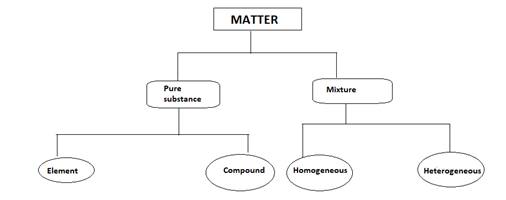
Interpretation:
The map showing the relationship between matter, elements, pure substance, compounds and homogeneous and heterogeneous mixtures needs to be explained.
Concept introduction:
The
Explanation of Solution
Substances that cannot be separated into other constituents and have a particular composition is known as pure substances.
Pure substances are further classified into two types:
- Mixture
- Compounds
Pure substances are pure in nature. They cannot be separated by physical process.
Examples of pure substances are gold and pure water.
- Elements are made up only one type of atoms.
For example, Cu, Na, Ne, etc.
- Compounds are made up of more than on the type of atoms.
For example, HCl, PCl5, etc.
- Mixtures are a combination of two or more pure substances.
Mixtures are impure in nature. They can be separated by several methods such as magnetic separation, evaporation, etc.
Examples of mixtures are oil and water, sand and sugar
Mixtures are of two types:
- Homogeneous mixture
- Heterogeneous mixture.
The mixtures in which the components are mixed uniformly are known as homogeneous mixtures. It is also known as solution. The homogeneous mixture cannot be judge by seeing it. They have only one phase. The homogeneous mixtures cannot be separated physically.
Examples of a homogeneous mixture are rainwater, vinegar, etc.
The mixtures in which the components are not mixed uniformly are known as heterogeneous mixtures. The heterogeneous mixture can be judge by seeing it. They have two or more phases or layers. The heterogeneous mixtures can be separated physically.
Examples of a heterogeneous mixture is a mixture of sand and sodium chloride.
The map is shown below:

Chapter 3 Solutions
Chemistry: Matter and Change
Additional Science Textbook Solutions
General, Organic, and Biological Chemistry (3rd Edition)
Organic Chemistry (9th Edition)
Essential Organic Chemistry (3rd Edition)
Chemistry: A Molecular Approach
Chemistry: The Central Science (13th Edition)
 ChemistryChemistryISBN:9781305957404Author:Steven S. Zumdahl, Susan A. Zumdahl, Donald J. DeCostePublisher:Cengage Learning
ChemistryChemistryISBN:9781305957404Author:Steven S. Zumdahl, Susan A. Zumdahl, Donald J. DeCostePublisher:Cengage Learning ChemistryChemistryISBN:9781259911156Author:Raymond Chang Dr., Jason Overby ProfessorPublisher:McGraw-Hill Education
ChemistryChemistryISBN:9781259911156Author:Raymond Chang Dr., Jason Overby ProfessorPublisher:McGraw-Hill Education Principles of Instrumental AnalysisChemistryISBN:9781305577213Author:Douglas A. Skoog, F. James Holler, Stanley R. CrouchPublisher:Cengage Learning
Principles of Instrumental AnalysisChemistryISBN:9781305577213Author:Douglas A. Skoog, F. James Holler, Stanley R. CrouchPublisher:Cengage Learning Organic ChemistryChemistryISBN:9780078021558Author:Janice Gorzynski Smith Dr.Publisher:McGraw-Hill Education
Organic ChemistryChemistryISBN:9780078021558Author:Janice Gorzynski Smith Dr.Publisher:McGraw-Hill Education Chemistry: Principles and ReactionsChemistryISBN:9781305079373Author:William L. Masterton, Cecile N. HurleyPublisher:Cengage Learning
Chemistry: Principles and ReactionsChemistryISBN:9781305079373Author:William L. Masterton, Cecile N. HurleyPublisher:Cengage Learning Elementary Principles of Chemical Processes, Bind...ChemistryISBN:9781118431221Author:Richard M. Felder, Ronald W. Rousseau, Lisa G. BullardPublisher:WILEY
Elementary Principles of Chemical Processes, Bind...ChemistryISBN:9781118431221Author:Richard M. Felder, Ronald W. Rousseau, Lisa G. BullardPublisher:WILEY





